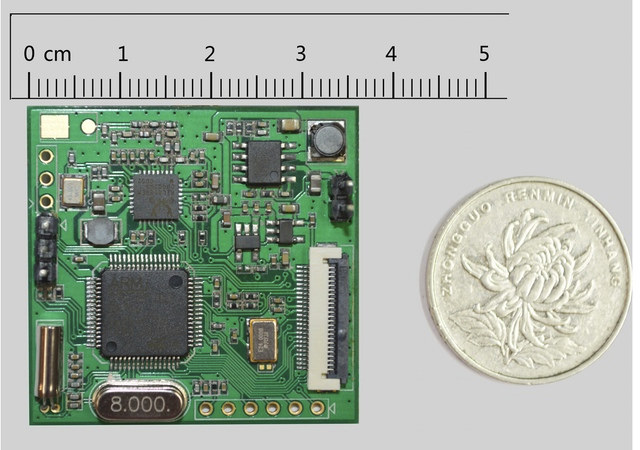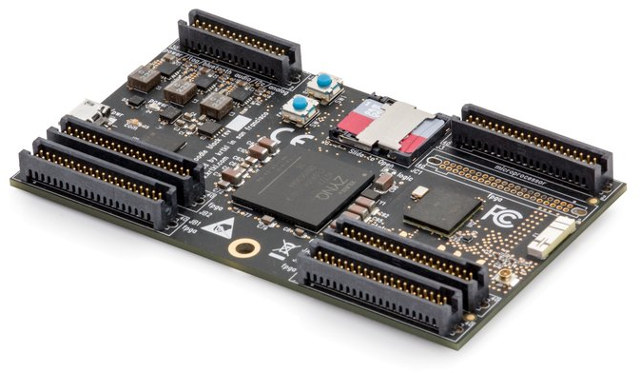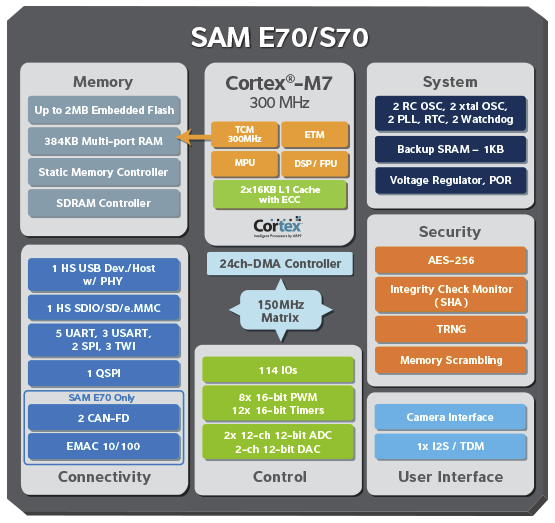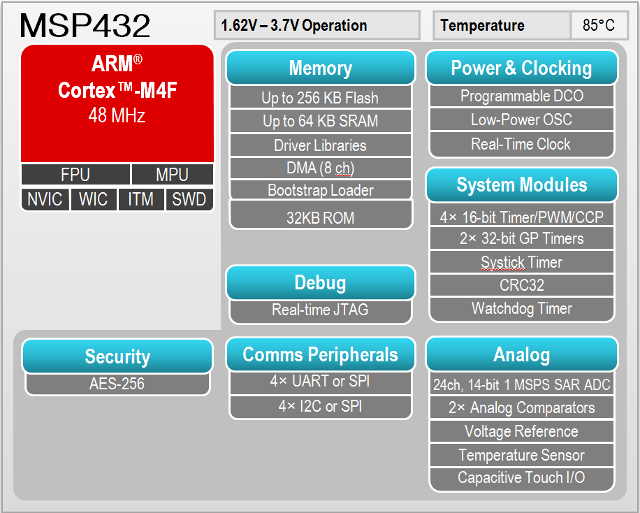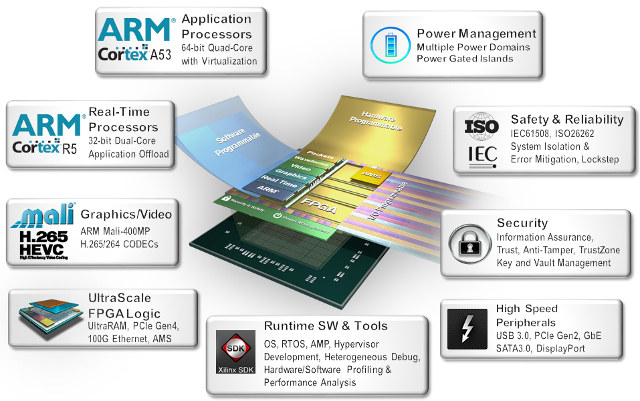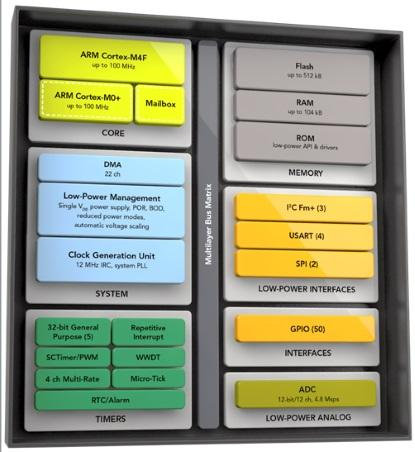Vigek IOT Core packs an STM32 MCU, a Realtek WiFi module, and 8-bit camera interface into a 3.6×3.75 cm board. It also provides GPIO, PWM, and analog input to interface with external hardware such as sensors, and the project had a modest, yet successful, Kickstarter campaign in the summer. Vigek IOT Core specifications: MCU – STMicro STM32F103 ARM Cortex-M3 micro-controller @ up to 72MHz Connectivity – 802.11b/g/n WiFi @ 54Mbps I/Os Up to 8 GPIOs, configurable as up to 4 analog inputs, and up to 6 PWM outputs I/O voltage tolerance – 0~3.6V I/O output current – Up to 8mA Camera – 8-bit camera interface, optional 2.0MP camera with OV2640 sensor Power supply – 3.3V ~ 24V Power Consumption – 32mA in active mode (WIFI connected, camera not working) Dimensions – 36mm x 37.5mm While Vigtek IOT Core can be used without programming, simply using an Android app to control the […]
Snickerdoodle Xilinx Zynq ARM + FPGA Board Starts at $55 (Crowdfunding)
While Xilinx Zynq UltraScale+ ARMv8 + FPGA SoC is still in development, there are already quite a few Xilinx Zynq-7000 boards on the market today. The cheapest I know of is MYirTech Z-Turn board selling for $99, but krtkl (pronounced “critical“), US a based startup, will soon bring an even cheaper Zynq-7010/7020 board with their Snickerdoodle board currently listed on CrowdSupply platform for $55 and up, plus shipping. Snickerdoodle board specifications: SoC Xilinx Zynq-7010 dual core Cortex A9 processor @ 667 MHz + FPGA with 430K gates or Xilinx Zynq-7020 dual core Cortex A9 processor @ 866 MHz + FPGA with 1.3million gates (~430K ASIC gates) System Memory – 512MB or 1GB LPDDR2-800 Storage – micro SD card slot, 16MB boot flash Connectivity via Ti Wilink 8 solution 2.4GHz 802.11 b/g/n WiFi + Bluetooth 4.0 or Dual band 802.11 b/g/n WiFi (2×2 MIMO) + Bluetooth 4.0 USB – 1x micro USB port […]
Atmel SAM S70 and SAM E70 Cortex M7 MCUs, SAM V71 Xplained Board Are Now Shipping
ARM Introduced Cortex M7 IP in September, and ST Micro simultaneously announced its STM32F7 Cortex M7 MCU clocked up to 200 MHz, and boards are now available, including some running Linux. But two other companies have licenses Cortex M7, Freescale with its Kinetis KV5x micro-controllers which are yet to be mass-produced, and Atmel which has recently announced their SAM S70 and E70 micro-controllers are now in mass production. SAM E70 and S70 have similar features, but E70 offers some extra interface like CAN and Fast Ethernet: ARM Cortex-M7 core running at up to 300MHz (1500 CoreMark) Up to 2MB Flash and 384kByte SRAM Floating point unit (FPU) for high-precision computing and accelerated data processing High-performance internal memory architecture with user configurable Tightly Couples Memories and System memory, and 16kB I and D-cache High Speed USB Host and Device with on-chip high-speed PHY CMOS image sensor interface AES hardware encryption engines, […]
Texas Instruments Introduces MSP432 ARM Cortex-M4F MCU Family
Texas Instruments has just launched a successor for its 16-bit MSP430 MCU family with MSP432 MCU series featuring a 32-bit ARM Cortex-M4F core, a DSP, up to 256 KB flash, up to 64 KB SRAM, and according to the company ” delivering a ULPBench score of 167.4 outperforming all other Cortex-M3 and -M4F MCUs on the market”. The new MCU family targets consumer & portable electronics, building & factory automation & control, smart grid & energy, healthcare & fitness, and wearables applications. Key features listed for MSP432P4xx: MCU – 32-bit ARM Cortex-M4F up to 48 MHz with FPU and DSP. Delivers 3.4 Coremark/MHz Memory – Up to 64 KB RAM; Selectable RAM retention Storage – Up to 256 KB Flash; dual bank for simultaneous reading and writing Security – 256-bit AES encryption, JTAG access lock, 4 IP Protection regions EnergyTrace Technology Real-time power measurement and debugging Generate application energy profiles including […]
Xilinx Introduces Zynq UltraScale+ MPSoC with Cortex A53 & R5 Cores, Ultrascale FPGA
Xilinx Zynq-7000 dual core Cortex A9 + FPGA SoC family was announced in 2012, and provides a wide range of SoC with features and price range, and led to low cost ARM + FPGA such as ZedBoard, and more recently Parallela and MYiR Z-Turn boards. The company unveiled its successor with Zynq UltraScale+ MPSoC providing five times more performance per watt, with four ARM Cortex A53 cores, two ARM Cortex R5 real-time MCU cores, a Mali-400MP GPU, an UltraScale FPGA fabric manufactured with 16nm FinFET+ process. There are two main sub-families in Zynq Ultrascale+ MPSoC for “smarter control & vision”, and “smarter network”. Both share the same processing systems (CPU, GPU, MCU, Peripherals, Security), but the networking family has beefier FPGAs, and lacks the H.264/H.265 video processing unit found in the control & vision version: Processing Systems Processor – Quad ARM Cortex A53 MPCore up to 1.3GHz Real-time Processor – […]
NXP Introduces LPC54100 Single & Dual Core Cortex M4F/M0+ MCU Family and LPCXpresso54102 Development Kit
NXP has recently introduced LPC54100 Series microcontrollers with a Cortex-M4F core up to 100MHz, and optionally an ARM Cortex M0+ core for always-on sensor processing applications, as well as LPCXpresso 54102 board. Typical applications include mobile, portable health and fitness, home and building automation, fleet management and asset tracking, robotics and gaming. Key features of LPC54100 series MCUs: CPU – 32-bit ARM Cortex-M4F up to 100 MHz, optional 32-bit ARM Cortex-M0+ coprocessor On-chip RAM – 104 KB internal RAM On-chip Storage – Up to 512 KB on-chip Flash Interfaces 3 fast-mode plus I²C, 4 UART, 2 SPI, 39 GPIO ADC with up to 12-channels, 12 bits, and 4.8 Msps sample rate, full-spec (1.62 V to 3.6 V) Clock Sources – IRC, digital clock input, PLL, 32 kHz XTAL, WWDT Timers – 5x 32-bit general-purpose timers/counters, One-state configurable timer/PWM, RTC with alarm, and WWDT 22-channel DMA with 20-programmable triggers Power consumption […]
Cortus Introduces APS23 and APS25 32-Bit Cores for Micro-controllers
ARM and MIPS are not the only games in town with it comes to 32-bit cores for micro-controllers. I’ve already written about Beyond Semiconductor, and mentioned Andes used in some Wi-Fi SoC, and today I’ve come across another IP company called Cortus. which just introduced APS23 and APS25 cores based on their latest Cortus V2 instruction set. which offers a smaller code footprint compared to there V1 ISA. APS23 can achieve 1.44 Coremarks/MHz, 2.83 DMIPS/MHz, and can run up to 200 MHz when manufactured with 90nm process, whereas APS25 is a bit more powerful with 2.09 Coremarks/MHz, 2.36 DMIPS/MHz, and can run up to 344 MHz. Minimal power consumption is 11.6 and 19.3 uW/Mhz for APS23 and APS25 respectively. Key features of both cores include: APS23 APS25 Excellent Code Density 3 stage pipeline 5-7 Stage Pipeline Sequential Multiplier High Performance Integer Multiply Optional Parallel Multiplier (Gives 2.62 Coremakes/MHz) Integer Divider Full Peripheral Set Dual […]


